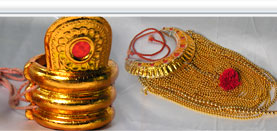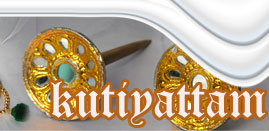 |
 |
 |
|
|||||||||||||||||||||||||||||||||||||
|
|
|
|||||||||||||||||||||||||||||||||||||||
|
Instruments Kutiyattam most commonly uses two ‘Mizhavu’ as the accompanying percussion instruments. As one keeps up the rhythm the other follows the movements of the performer. A Mizhavu is a copper pot with its mouth covered with animal skin. In earlier day earthen pots were used and later, perhaps due to difficulties in traspoting, they were replaced by copper drums. Most percussion instruments like Maddalam, Mridangam, Tabala,  Ganjira, Ghatam etc., use fingures to produce sound. The playing of the Mizhavu
resembles that of the Timila. Nowadays novel artforms like Tayambaka are played
out on the Mizhavu. Beside Mizhavu, Idakka, Kurunkol and Kuzhithalam are also
use, in a Kutiyattam perfoemance. Earlier Suddha maddalam and Timila alone
were believed to have been used Ganjira, Ghatam etc., use fingures to produce sound. The playing of the Mizhavu
resembles that of the Timila. Nowadays novel artforms like Tayambaka are played
out on the Mizhavu. Beside Mizhavu, Idakka, Kurunkol and Kuzhithalam are also
use, in a Kutiyattam perfoemance. Earlier Suddha maddalam and Timila alone
were believed to have been used
|
|||||||||||||||||||||||||||||||||||||||
|
|
|
|
|
|
||||||||||||||||||||||||||||||||||||
| All rights reserved. Best Viewed in 1024 X 768, IE 4.0+ | CREDITS | Site
designed and developed by C-DIT.for Unesco |